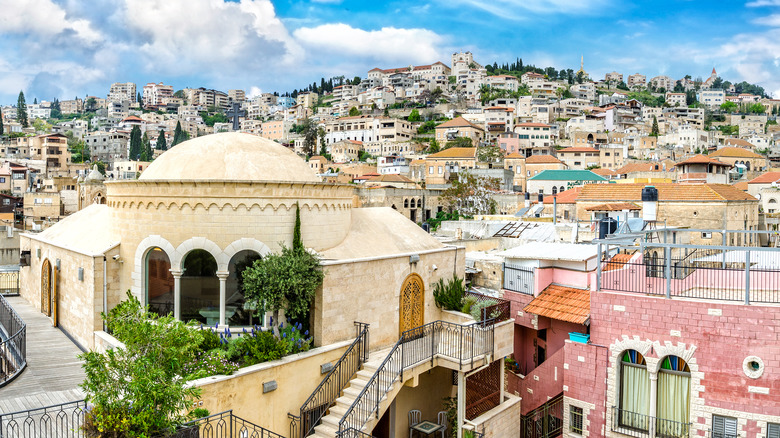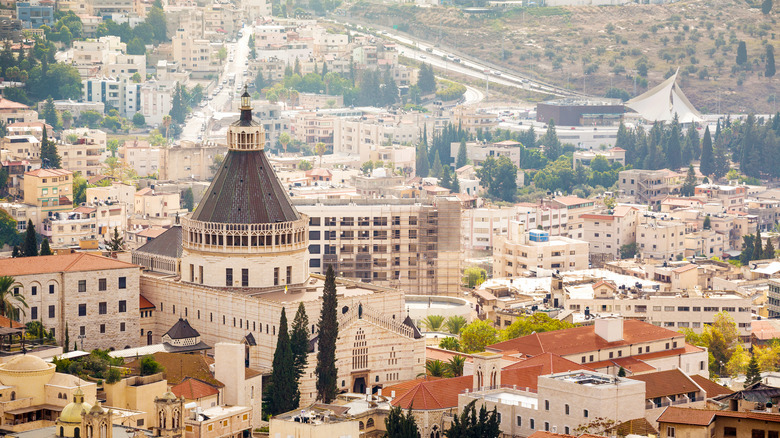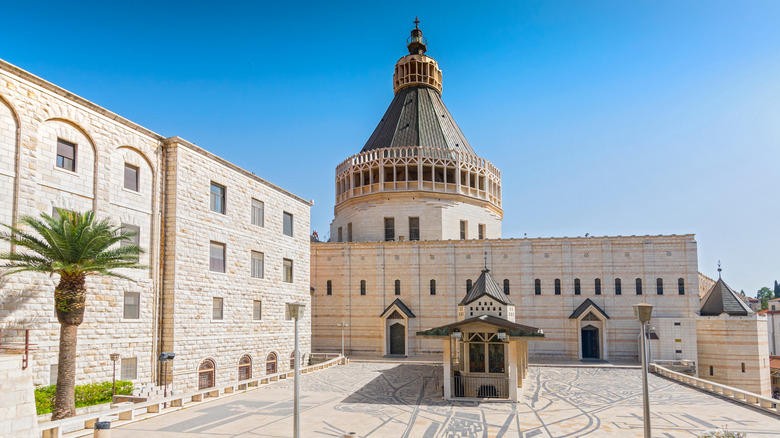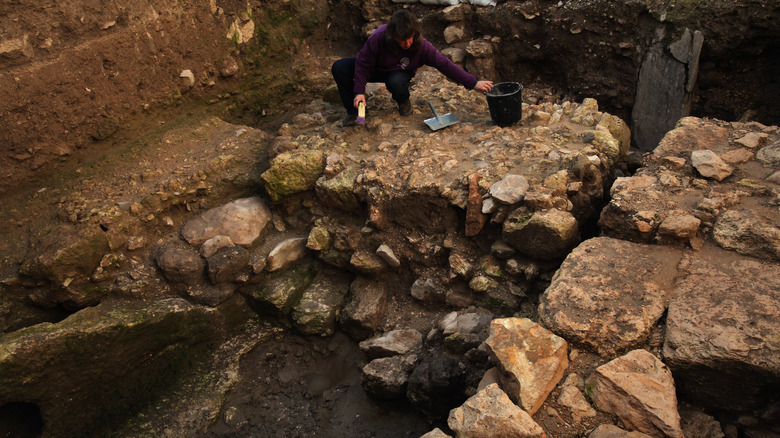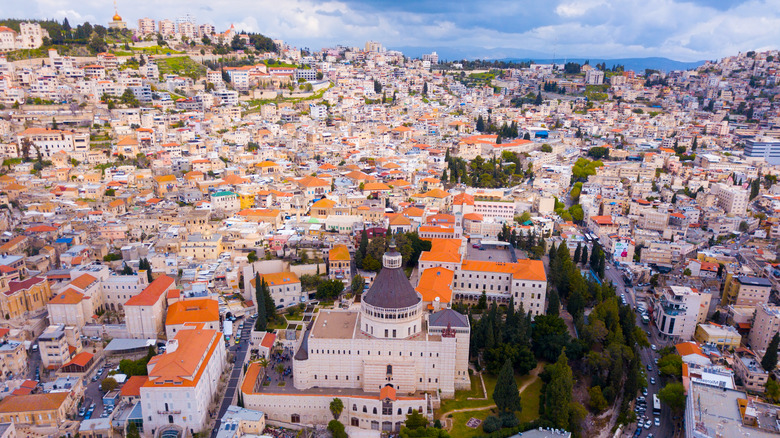The Untold Truth Of Nazareth
In the northern reaches of Israel, in Lower Galilee, lies the city of Nazareth, a town draped in historical and religious significance. Known as an-Nasira in Arabic and Nazerat in Hebrew, Nazareth is the largest Arab city in all of Israel, yet is a site of Christian pilgrimage (via Britannica). The city is globally known as being the hometown of Jesus, as described throughout the New Testament's four Gospels.
Nazareth is not mentioned anywhere in the Old Testament or rabbinic literature, despite originally having a Jewish population. This could be because the town was originally an insignificant village with a less-than-flattering reputation; In the Gospel of John, Nathanael asks, "Can anything good come out of Nazareth?" The question is often interpreted as indicating the town's less than sterling reputation. Yet its Biblical relevance and deep historical significance mean the city of Nazareth has come a long way from its modest introduction in the New Testament.
Nazareth began around 9,000 years ago
According to New World Encyclopedia, the earliest signs of civilization at Nazareth come from a funerary site dated to around 9,000 years ago. Decorated skulls and large headstone structures lead archaeologists to believe that Nazareth was an important center for the local Neolithic Era cult, indicating that Nazareth already had religious value millennia before the New Testament was written.
At the time of the first Christian writings, Nazareth could have been anywhere between a hamlet of a few dozen people to a modest town of around 2,000, functioning as a sort of ancient suburb for the nearby city of Sepphoris. However, it's quite possible that the town was not called "Nazareth" in the time of Jesus, as there are no textual references to that name in ancient Jewish sources, with the early recorded reference coming in the 3rd century A.D. Whatever the city was called before the New Testament is not currently known.
Nazareth was attacked several times
Even though Nazareth's origins are mysterious and murky, it didn't take long for the city to become an important and cherished Christian pilgrimage site. According to Haaretz, Nazareth arose as a religious center not just for being the hometown of Jesus, but also the Cave of Annunciation, where an angel is said to have revealed to Mary that she would give birth to the son of God.
By the end of the fourth century A.D., pilgrims were making their way to Nazareth. By the fifth century, churches were being constructed. In the next few centuries, the many conquerors of Nazareth damaged Christian holy sites throughout the city, including the Church of the Annunciation. Nazareth's importance to Christians made it an easy target for religious enemies, and there was no shortage of that in the Middle East. The constant damage and destruction to the city would change in 1099, however, when the Crusaders arrived.
Nazareth was a target during the crusades
Nazareth had been at the mercy of the Persians and the Arabs in the centuries leading up to 1099, when a crusade was launched (via Jewish Virtual Library). The Crusader Tancred then captured Nazareth, and built a church with fine architecture that displayed proud French workmanship. According to Haaretz, Tancred's funding allowed the church to become one of the largest holy buildings in the crusader kingdom, and the French knight became head of the crusader principality in Galilee.
The crusader control over Nazareth would last less than a century. In 1187, Arabian leader Saladin was victorious over the Crusader forces, sending soldiers and clergymen fleeing to the coast. The fate of Nazareth's Christians was unpleasant, as they were either imprisoned or massacred by Saladin's men, who also damaged and profaned the Christian holy sites within the city. Nazareth returned briefly to Christian hands in the mid-1200s, but by 1263 a pogrom was ordered against all Christians in the area, and the holy city fell into ruin for 400 years.
Nuns excavated the possible house of Jesus
In 1620, a group of Catholic Franciscans received permission from the emir to return to Nazareth and begin a rebuild after four centuries of neglect and ruin (via Jewish Virtual Library). The ancient city recovered slowly and steadily, and a new church was built in 1730. It was around this time that a group of nuns made a startling archaeological discovery, and took it upon themselves to excavate it before it could be destroyed by the new construction around the city (via Live Science).
The sisters discovered a house cut into hillside that dated all the way back to the first century. Further excavation revealed a fourth century church, built upon a cave church that was the supposed former home of Mary, the mother of Jesus. The nuns conducted probably the only all-female archaeological dig of the century, and also discovered a tomb and sarcophagus, along with evidence that the church and house had been hurriedly sealed to protect it from the violence and destruction to come. They were successful. The nuns safely unearthed what is now known as the House of Jesus, although it's not known for certain if Jesus ever actually lived there.
Nazareth is trying to be a tourism destination
Today, Nazareth advertises itself as not just a place for Christian pilgrims, but a destination for tourists of all faiths (via Elal). Beyond the historical churches, mosques, and synagogues found throughout the city, Nazareth claims to have spice shops, markets, festivals, scenic views, and a diverse culture that can only be found in the unique circumstances arising from a Muslim-majority city in the Jewish-dominated Israel that is a holy site for Christians.
Yet that multicultural makeup has led to conflict before, and it continues to lead to conflict today. Being the most predominant Arab city in Israel means that Nazareth is a growing target for religious clashes, particularly as the Israel-Palestine crisis worsens as the years go by. According to a report by YNet News from last May, riots broke out in the city as Nazareth's Arab population showed solidarity with the Palestinians and Arabs in Jerusalem who were blocked off from prayer during Ramadan. The clashes with police proved that although Nazareth has overcome much violence in its history, religious struggles are still present in what's widely regarded as the hometown of Jesus.
